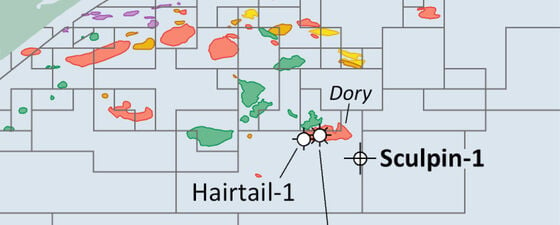ExxonMobil have recently completed a three-well drilling campaign on VIC/P70 offshore Gippsland Basin, south-east Australia.
Location of the Sculpin-1 well.
ExxonMobil have recently completed a three-well drilling campaign on VIC/P70 offshore Gippsland Basin, south-east Australia. The first two wells, Baldfish-1 and Hairtail-1, were reported dry in 2018, whilst the latest well Sculpin-1, is expected to be reported dry, with no announcement to the contrary. Sculpin-1 was drilled to about 4,700m in an Australian record-breaking 2,239m of water.
ExxonMobil were hoping to build on the Dory gas discovery of 2008 in the north of the block, although the location of Sculpin-1 further south in the block suggests a step out from this play. Apache originally drilled Dory 1 in 2008 and found 30m gas in good quality reservoir in the Latrobe (Upper Cretaceous) Group, before the well was plugged and abandoned as sub-commercial. Liberty took that license and ExxonMobil bought P70 in 2017 for an undisclosed amount, with press reports talking about potentially 2 Tcfg at Dory. Failure here could be attributed to structure as depth conversion plays a role over a subtle trap; Dory and other prospects do not ‘close’ in time due to deepening water and deep canyons at the water bottom, and large velocity variations in the carbonates above the target Latrobe group. The stratigraphic nature of the Latrobe nearshore and shoreface sands with fluvio-deltaics also poses challenges for trapping and seal. The jury is out on whether the block will deliver on multi-Tcf promises, and whether Dory is a big enough fish for ExxonMobil to go ahead and develop. Indeed, rumors already circulate that this will be one of many assets subject to ExxonMobil’s global divestment strategy.





